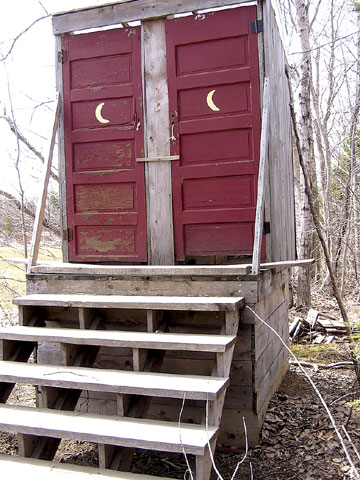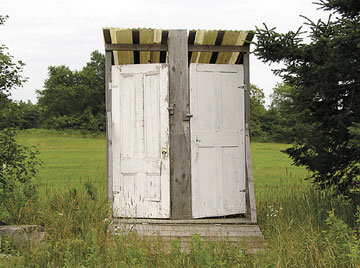 |
| Volunteers built the first Common Throne in 2004 in the North/Rose Gate volunteer camping area. Volunteers, bicyclists and vendors at that end of the grounds quickly discovered its convenience. English photo. |
… at MOFGA’s Common Ground Education Center:
Recovering a Resource from the Waste Stream
by Nancy Rosalie
The Maine Organic Farmers and Gardeners Association has been building composting outhouses, garnering not only good reception from Common Ground fairgoers but a very usable fertilizer as well. Our system works well for our short-term, annual event, and we keep adding new composting outhouses to supplement the conventional toilets and portable toilets that serve some 60,000 visitors to the Fair.
Humble Beginning
In 2003, the coordinators in charge of camping for volunteers during the Fair expressed a desire to build an outhouse for the camping area. Interested people met, including volunteer camping coordinators Mary Chamberlin and Chris Fabian; and Becca Smith, Steve Plumb, Barbara Luce (Fair director at the time) and Nancy Rosalie, with the goal of building a composting outhouse in the North/Rose Gate volunteer camping area. Each of the coordinators uses some form of sawdust toilet at home, inspired by Joe Jenkins’ The Humanure Handbook.
We met monthly to explore legalities, permitting, funding and designs. We were inspired by a field trip to Avena Botanicals and by “treebogs” (composting chambers made of woven, living willow or other plants that take up nutrients and grow quickly, thus converting humanure to biomass directly; see, for example, https://en.wikipedia.org/wiki/Tree_bog). We familiarized ourselves with some of the other outhouse systems used around Maine, most in remote hiking areas. We estimated usage and sized our plans accordingly. We found a wonderful ally in our soils engineer, Dave Studer of Washington, Maine.
By May 2004, we had settled on the name “Common Throne” and had finalized our plans. At a work party on June 19, we began building, and our first throne was initiated at the 2004 Fair – and was well used! Campers loved it. We were low-key about this first effort, tucking it just inside the tree line, but bicyclists and farmers’ market vendors discovered it nonetheless.
In the winter of 2004-2005, we monitored this throne and eyeballed future sites. The pile heated, and Woods End Lab tested it for E. coli, with results well within acceptable limits. The throne was spruced up and used again at the 2005 Fair. We would love to find a college student who would do a yearlong study of temperatures and work with a lab to test for pathogens, nutrient levels and biological activity.
 |
| Another throne serves the south parking lot tent camping area. English photo. |
 |
| This facility went up in 2007 along the Woods Road for folks walking to and from the Fair and for the Low-Impact Forestry group to use during its fall, winter and spring workshops. English photo. |
If at First You Succeed …
Reinvigorated by the energies of Lew McGregor and Mark Durbin in 2006, we built another throne, this one in the south parking lot tent camping area. In 2007, we built two more – one along the Woods Road for folks walking to and from the Fair and for the Low-Impact Forestry group to use during its fall, winter and spring workshops; and a second in the volunteer camping area, closer to the amphitheater. These two made our grand experiment very visible, and we continued to receive much positive feedback.
Our crowning achievement to date has been the triple-sized throne built in 2008, mostly by Wes Cotton, with help from Dennis Carter and Annelie Sunqvist.
A soils engineer tests each site before a throne is built, and we get a plumbing permit for each site. The larger throne also needed a building permit from our town.
Design Features
Our key feature is an aboveground composting chamber, made with four cedar corner posts and boarded walls, that is lined with hay bales. When people use the toilet, they cover their contributions with sawdust, and the pile accumulates for about a week in late September – three days of the Fair plus a few days when volunteers set up before the Fair and a few days breaking down after the Fair. The pile is undisturbed until late the following August – 11 months of working its magic – at which time the compost is scooped out, fresh hay bales are added as needed, and we’re ready for another Fair.
Our first Common Throne has a 6-by-6-foot footprint. The chamber is about 4 feet high, and the outhouse is on top of that. Hay bales inside the chamber create a space about 3 feet by 3 feet. One wall of the chamber is removable.
The outhouse on top of the chamber is 4 feet by 6 feet with a 2-foot porch along the front and stairs to ascend to the throne. Divided in half, this makes two stalls, each 3 feet by 4 feet, with a door to access each stall. The front “wall” consists of a built vent stack (about 8 inches by 12 inches) and the two doors, which close against the stack. An interior wall built between the back wall and the stack creates the two stalls. A shed roof of corrugated clear plastic admits light during the day. Our town recycling center was most helpful, and it’s amazing how many people have discarded doors stored in their barns. Even in the city, people put them out for trash pickup.
After two fairs with successful usage and favorable comments, we built another throne in another parking/camping area. This one takes advantage of a bank, so access to the chamber is at the lower ground level, and access to the outhouse is at the upper ground level – a real bonus.
 |
| Volunteers’ crowning achievement to date is the triple-sized throne built in 2008, situated by the livestock area. English photos. |
The next year, we built two more two-holers with the 6-by-6-foot footprint.
Last year we went bigger. The new throne has an 8-by-24-foot footprint, with a two-holer at each end sandwiching a men’s urinal, beneath which we placed sawdust. The stalls are 4 feet by 6 feet, and we would not go back to the smaller footprint. People really like these roomy, light spaces that have less of an outhouse feel.
Much of the lumber comes from trees felled and milled on MOFGA’s land by the very active low-impact forestry horse-logging group that is whipping our pine woods into shape. The outhouses are light construction, and the first several were built in pieces and screwed together so that they could be taken apart and moved if needed.
Clear or translucent roofing improves the atmosphere, as do doors with windows using “frost” paint or contact paper for privacy. Toilet seats are mounted on chutes made from 5-gallon metal cans that we get from a theater that gets popcorn in them. We fill used grain bags with sawdust from Peter Baldwin’s apple ladder shop. We cut sawdust scoops from plastic jugs. (Quart maple syrup jugs are great.) Waste baskets are 2- to 3-gallon plastic plant pots.
We had so much fun figuring out the men’s urinal! We cut down plastic Kitty Litter jugs, used hose clamps to attach old bicycle tubes to the spouts, and tucked the tubes through holes in the floor.
 |
Maintaining Thrones and Using the Product
During the Fair, volunteer “Queen Bees” or “Throne Crones” check the thrones, clean messes, sweep, refill toilet paper dispensers and replace empty sawdust bags with full bags.
The resulting compost has been spread around rugosa rose bushes lining MOFGA’s hayfield/parking lots. This is not part of MOFGA’s certified-organic land, so spreading humanure there is permitted. (And, according to Maine DEP regulations, we cannot spread the humanure off-site.)
The thrones have been built mostly with volunteer labor, at very little cost, and with lots of re-used materials. In 2008, we even used hay cut and baled at MOFGA’s Common Ground Education Center.
More composting toilets are in the works. Future sites include the waiting area near the red barn/tractor shuttle, the staff camping area, and the south lot tent camping area.
Nancy Rosalie will give tours of the Common Thrones each day of the Common Ground Country Fair. For times, please see the 2009 Fair Schedule of Events.
Austin, Texas, Approves Composting Toilet
The city of Austin, Texas, approved a composting toilet this June – possibly the first city to do so. The structure is on a former landfill owned by the Rhizome Collective. It contains two commodes. One is used for a year, then, when its vault is full, it is sealed for a year while the other is used. The toilets will save the average three gallons of water used per flush in conventional toilets. Joseph Jenkins, author of the Humanure Handbook, told the Austin American-Statesman that he knows of no other cities that officially recognize humanure toilets.
(“‘Humanure’ Victory: Green Toilet Wins Austin City Approval,” by Asher Price, Austin American-Statesman, June 19, 2009; reprinted in www.commondreams.org/headline/2009/06/19-5)
